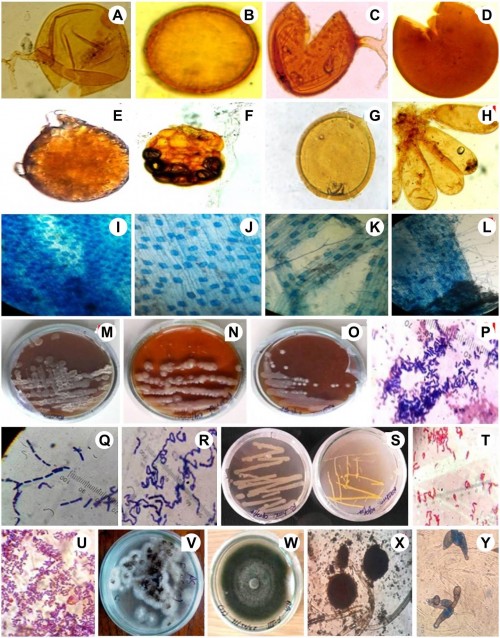Tropical Plant Research
An International Journal by Society for Tropical Plant Research
2019, VOLUME 6 ISSUE 2Pages: 299-305
Rhizospheric microbiota and its diversity associated with Zephyranthes rosea Lindl.: A medicinally important bulbaceous plant
Rashmi Singh, Akshita Gaur and Vipin Parkash*
*Forest Protection Division, Forest Research Institute, Indian Council Forestry Research & Education, Dehradun-248006, Uttarakhand, India
Abstract:
Zephyranthes rosea, belonging to family Amaryllidaceae commonly known as ‘Rain lily’, is a bulbaceous species native to Peru and Columbia. In India, the plant species is used in folk medicine along with Z. flava for treatment of diabetes, ear and chest ailments and viral infections. A study was conducted to see the diversity of microbes associated with rhizosphere of this plant. It was observed that fungal species such as Alternaria zinniae, Aspergillus niger, Penicillium sp., Paecilomyces sp. were present in the rhizosphere. Among the bacterial diversity, 3 different species of Bacillus and only 1 Streptobacillus sp. was isolated. Some endomycorrhizal species i.e. Gigaspora gigantea, Acaulospora bireticiulata, Glomus macrocarpa, Glomus sp.-1, Sclerocystis coccogenum, Sclerocystis sinuosa,Glomus mosseae, Glomus sp.-2, were isolated from the rhizospheric soil samples. The roots were detected for extreme arbuscular mycorhizal endomycorrhizal fungal infection with Arum type colonization having rectangular and profuse vesicles with hyphae entering the cortical cells of root. About 3 different species of Actinomycetes i.e. Streptomyces spp. were too observed in the rhizosphere. The study indicates that the target plant species is heavily dependent on endomycorrhizal fungi and other microbes (fungal, bacterial and actinomycetes) and the microbial interaction can be attributed to the presence of some toxic alkaloids in the bulbs of the plant as per the literature review and thus, this area needs to be further explored.
Zephyranthes rosea, belonging to family Amaryllidaceae commonly known as ‘Rain lily’, is a bulbaceous species native to Peru and Columbia. In India, the plant species is used in folk medicine along with Z. flava for treatment of diabetes, ear and chest ailments and viral infections. A study was conducted to see the diversity of microbes associated with rhizosphere of this plant. It was observed that fungal species such as Alternaria zinniae, Aspergillus niger, Penicillium sp., Paecilomyces sp. were present in the rhizosphere. Among the bacterial diversity, 3 different species of Bacillus and only 1 Streptobacillus sp. was isolated. Some endomycorrhizal species i.e. Gigaspora gigantea, Acaulospora bireticiulata, Glomus macrocarpa, Glomus sp.-1, Sclerocystis coccogenum, Sclerocystis sinuosa,Glomus mosseae, Glomus sp.-2, were isolated from the rhizospheric soil samples. The roots were detected for extreme arbuscular mycorhizal endomycorrhizal fungal infection with Arum type colonization having rectangular and profuse vesicles with hyphae entering the cortical cells of root. About 3 different species of Actinomycetes i.e. Streptomyces spp. were too observed in the rhizosphere. The study indicates that the target plant species is heavily dependent on endomycorrhizal fungi and other microbes (fungal, bacterial and actinomycetes) and the microbial interaction can be attributed to the presence of some toxic alkaloids in the bulbs of the plant as per the literature review and thus, this area needs to be further explored.

Fig.: Microbial diversity of Rhizospheric soil samples of Zephyranthes rosea Lindl.: A, Gigaspora gigantia; B,Acaulospora bireticiulata; C,Glomus macrocarpum; D–E,Glomus sp.; F,Sclerocystis coccogena; G,Glomus mosseae; H,Sclerocystis sinuosus; I–L,AM Fungal Infection; M–O,Streptomyces spp. onto culture medium P–R,Microscopic images of Streptomyces spp.; S,Bacillus spp. on Nutrient Agar; T,Microscopic view of Streptobacillus sp.; U, Microscopic image of Bacillus sp. V–W,Aspergillus niger and Alternaria zinniae on culture medium; X–Y,Microscopic images of Aspergillus niger and Alternaria zinniae.
| 0 | 1 | 2 | 5 | 9 | 5 | 0 | 0 |


